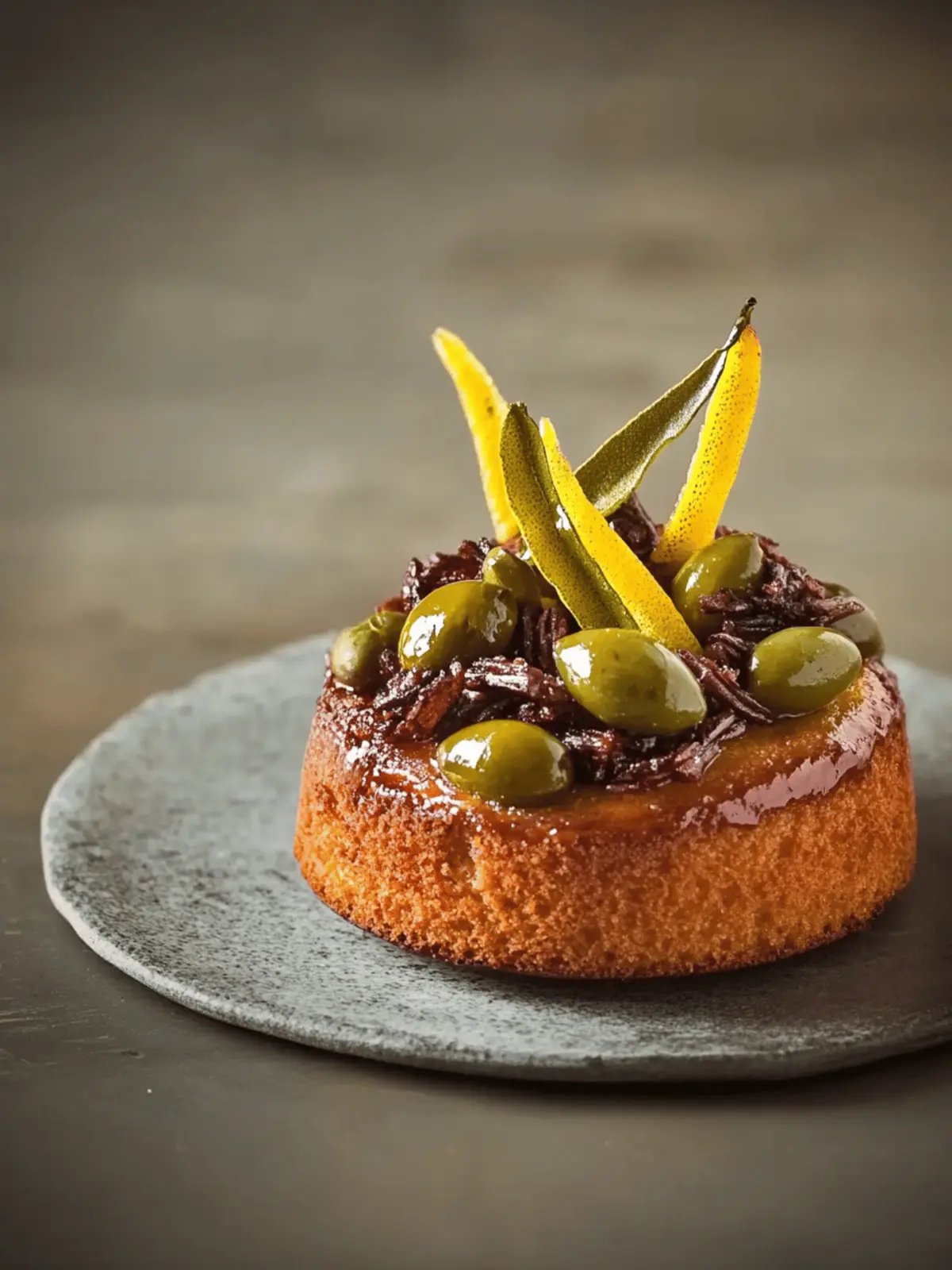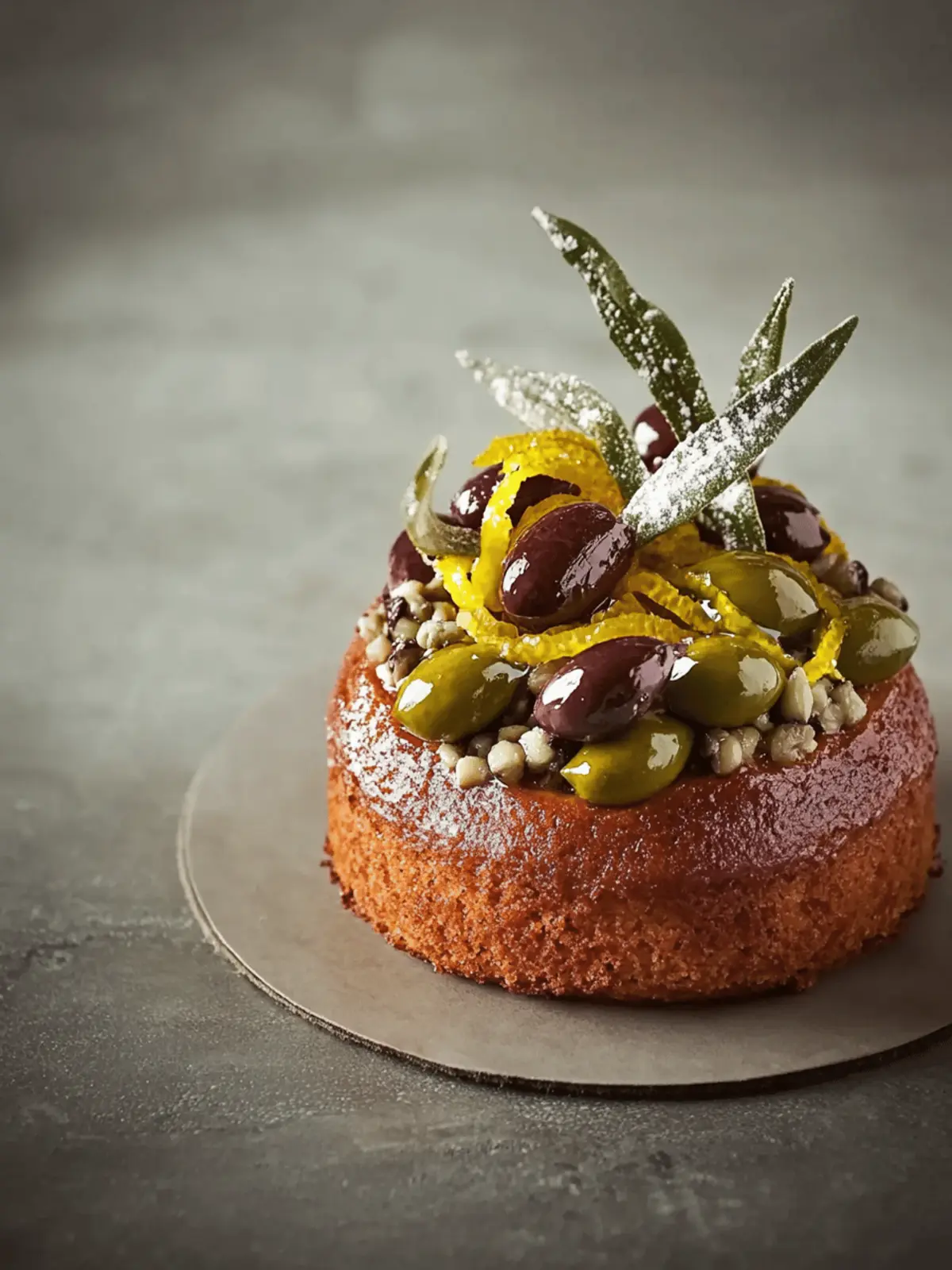As the sun filters through my kitchen window, I find myself drawn to the captivating blend of citrus and savory aromas wafting through the air. This Lemon and Olive Tea Cake is not just a dessert; it’s a delightful exploration of flavors that dances gracefully between sweet and savory. The moment I took my first bite, the moist crumb, enriched by the unique essence of kalamata olives, transported me to a Mediterranean café where traditional baking meets innovative twists.
What I love about this recipe is how effortlessly it bridges casual afternoons with elegant gatherings. Just imagine serving a slice of this sophisticated cake at your next tea party or even as a surprise treat after dinner – it’s a sure-fire conversation starter! With its vibrant lemon zest and the comforting heartiness of olives, it’s always a crowd-pleaser. Whether you’re a seasoned baker or a culinary novice, this will surely add a touch of magic to your kitchen adventures. Let’s dive into this delightful recipe that promises to break away from the usual and delight your palate!
Why is Lemon and Olive Tea Cake special?
Uniqueness: This Lemon and Olive Tea Cake combines unexpected flavors that harmoniously mingle, offering a sophisticated culinary experience.
Elegant Presentation: The beautiful marbling of bright lemon and olive paste makes it an eye-catching centerpiece.
Versatile Serving: Perfect for afternoon tea, dessert parties, or simply as a unique treat, it fits any occasion effortlessly.
Crowd-Pleasing Appeal: With its balanced sweet and savory profile, it’s sure to intrigue and satisfy guests of all tastes.
Easy to Make: Even novice bakers will find it straightforward, with simple steps that lead to impressive results.
Flavorful Journey: The vibrant citrus aroma will invigorate your kitchen, transporting you to the sun-drenched Mediterranean with every slice.
Lemon and Olive Tea Cake Ingredients
For the Cake
• Caster Sugar – Adds sweetness and moisture to the cake. Granulated sugar can be used if necessary.
• Maldon Salt – Enhances flavor balance. Feel free to use sea salt as an alternative.
• Lemon Zest – Provides vibrant citrus flavor. Always use fresh lemons for the best results.
• T45 Flour – This soft flour is perfect for delicate cakes. You can substitute with all-purpose flour if needed.
• Baking Powder – Acts as a leavening agent to help the cake rise.
• Eggs – Provides structure and moisture. Egg substitutes will change the cake’s texture.
• UHT Whipping Cream – Adds richness and a tender crumb. Heavy cream works well as a substitute.
• Unsalted Butter – Adds flavor and moisture. Margarine can be used, although it may affect taste.
• Olive Oil – Contributes moisture and flavor, keeping the cake tender. Other neutral oils can be used; just know it will alter flavor.
• Kalamata Olives (Dried and Fresh) – Provides a unique savory element to the cake. You can substitute with black olives if needed.
• Confit Lemons – Adds an intense lemon flavor and sweetness. Omitting them will change the flavor profile but is acceptable.
• Glucose Syrup – Helps create a glossy glaze. Honey can be a substitute in a pinch for similar texture, but it will add sweetness.
How to Make Lemon and Olive Tea Cake
-
Prepare Lemon Cake Mixture: In a large mixing bowl, combine lemon zest with caster sugar and mix well. Then, add Maldon salt, T45 flour, and baking powder to the lemon-sugar blend. Finally, mix in the eggs and UHT whipping cream until creamy and smooth.
-
Incorporate Fat: Gently fold in melted unsalted butter and olive oil into the batter. This will create a rich and moist texture. Once combined, cover the mixture and refrigerate overnight to enhance the flavors.
-
Confit Lemons: Bleach the lemon peels by blanching them three times in boiling water to remove any bitterness. Next, in a small saucepan, combine the peels with glucose syrup and sugar, simmering until it becomes syrupy.
-
Prepare Olive Paste: Blitz the kalamata olives in a food processor until smooth. Then, take a portion of the chilled lemon cake batter and mix it with the olive paste, ensuring an even distribution of savory flavor.
-
Bake: Preheat your oven to 170°C (gas mark 3). Prepare your cake tins by greasing them lightly. Layer the prepared cake batter and olive paste mixture, using a skewer to create a marbled effect. Bake for approximately 22 minutes or until a toothpick comes out clean.
-
Cool and Glaze: After baking, allow the cake to cool slightly in the tins before removing. Once fully cooled, glaze the cake with a mixture of lemon juice and extra glucose syrup for a beautiful finish.
-
Garnish and Serve: Finally, top the cooled cake with sliced olives and confit lemon for an elegant presentation. Slice and enjoy your delicious Lemon and Olive Tea Cake!
Optional: Serve warm or at room temperature for the best flavor experience.
Exact quantities are listed in the recipe card below.
Lemon and Olive Tea Cake Variations
Embrace your creativity by choosing one of these delightful twists to elevate your Lemon and Olive Tea Cake experience.
-
Herb-Infused: Add fresh rosemary or thyme for a delightful herbal note that complements the savory olives beautifully.
-
Citrus Swap: Try using orange or lime zest in place of lemon for a refreshing alternative that brightens the cake in a different way.
-
Nutty Addition: Fold in chopped almonds or pistachios to add a satisfying crunch that contrasts with the cake’s moist texture.
-
Sweet and Savory Twist: Incorporate a drizzle of honey or maple syrup into the olive paste for a sweet-savory flavor explosion that will surprise your taste buds.
-
Cheese Delight: Add crumbled feta cheese to the olive paste for a creamy richness that enhances the savory profile of the cake.
-
Flour Alternatives: Use almond flour or coconut flour for a gluten-free version, keeping in mind that textures may vary.
-
Spicy Kick: Mix in a pinch of red pepper flakes or finely chopped pickled jalapeños for a touch of heat that balances the cake’s sweetness.
-
Chunky Texture: Instead of blending olives into a paste, leave some chopped kalamata olives for added texture and bursts of flavor in every bite.
Storage Tips for Lemon and Olive Tea Cake
Room Temperature: Store in an airtight container at room temperature for up to 3 days to maintain its moist texture and flavor.
Fridge: If you want to extend freshness, refrigerate for up to 5 days. Just be sure to wrap it tightly to prevent it from drying out.
Freezer: For longer storage, freeze slices wrapped in plastic, then in aluminum foil for up to 3 months. Thaw in the fridge before serving.
Reheating: To enjoy warm, gently reheat individual slices in the microwave for about 15-20 seconds, or in a preheated oven at 150°C (300°F) for 5-7 minutes.
Make Ahead Options
These Lemon and Olive Tea Cake preparations are perfect for busy home cooks looking to save time! You can mix the cake batter up to 24 hours in advance; just be sure to refrigerate it tightly covered to maintain its freshness. The confit lemons can also be prepared ahead and stored in an airtight container for up to 3 days, enhancing their flavors. When you’re ready to bake, simply layer the olive paste with the chilled batter and pop it in the oven. This way, you’ll have a beautifully marbled cake with all the delightful flavors, making your baking experience just as enjoyable as the final result!
What to Serve with Lemon and Olive Tea Cake?
Pair this exquisite dessert with complementary flavors and textures for a memorable dining experience that intrigues the palate.
- Fresh Berry Compote: A vibrant medley of mixed berries adds a burst of tartness that beautifully balances the cake’s sweetness.
- Sliced Citrus Salad: Juicy oranges and grapefruits bring a refreshing, zesty contrast that enhances the cake’s lemony notes.
- Vanilla Ice Cream: Creamy, cool vanilla ice cream melts over warm slices, creating a delightful interplay of temperatures and flavors.
- Herbed Yogurt: A dollop of tangy yogurt infused with fresh herbs, such as mint or basil, introduces a savory note that complements the olives.
- Sparkling White Wine: This light, bubbly accompaniment elevates the experience, providing a crisp and refreshing kick with each sip.
- Lemon Thyme Shortbread Cookies: These buttery treats are a lovely side, echoing the lemon zest while adding a delightful crunch.
- Honey Drizzle: A simple touch of honey drizzled over the cake enhances the sweetness while harmonizing with the salty olives.
- Lavender Iced Tea: The floral notes of this tea create a refreshing contrast, perfect for sipping alongside your cake.
Expert Tips for Lemon and Olive Tea Cake
- Blanching Lemons: Properly blanch lemon peels three times to reduce bitterness; this step is crucial for achieving a balanced flavor in your Lemon and Olive Tea Cake.
- Cooling Time: Allow the cake to cool completely before glazing to prevent decorations from sliding off, ensuring an elegant presentation.
- Marbling Technique: Use a skewer to create a beautiful swirl pattern when layering the batters, enhancing both the visual appeal and flavor distribution.
- Ingredient Substitutions: If you don’t have T45 flour, all-purpose flour is a good substitute, but it may slightly change the cake’s texture.
- Serving Suggestion: For a delightful pairing, serve this unique cake with a side of fresh berries or a scoop of vanilla ice cream, balancing the flavors beautifully.
Lemon and Olive Tea Cake Recipe FAQs
What kind of lemons should I use for the confit lemons?
I recommend using fresh, organic lemons for confit, as their zest is brighter and more flavorful. Regular lemons will work too, but ensure they’re firm, without dark spots or blemishes. Clean the lemons thoroughly before peeling.
How should I store leftover Lemon and Olive Tea Cake?
Store leftovers in an airtight container at room temperature for up to 3 days for the best flavor. If you want to keep it longer, refrigerate it for up to 5 days, but wrap it well to avoid drying out. This cake is best enjoyed fresh!
Can I freeze Lemon and Olive Tea Cake?
Absolutely! To freeze, wrap individual slices in plastic wrap, followed by aluminum foil, storing them in a freezer-safe bag. They can be frozen for up to 3 months. Thaw them slowly in the fridge overnight before enjoying, or pop them in the microwave for a quick reheat.
What should I do if my cake doesn’t rise properly?
If your cake doesn’t rise, it may be due to expired baking powder or improper mixing. Always check the baking powder’s expiration date and ensure it’s well incorporated into your dry ingredients. Mixing too much or too little can also affect the texture, so aim for a smooth batter without over-mixing.
Is this recipe suitable for people with nut allergies?
Yes, the Lemon and Olive Tea Cake doesn’t contain nuts, making it a safe option for those with nut allergies. However, always double-check your ingredient brands, particularly the olive paste and any substitutes you use, to ensure they’re nut-free.
Can I substitute T45 flour with another type of flour?
Certainly! While T45 flour is perfect for its softness, you can easily substitute it with all-purpose flour. Just keep in mind it may slightly alter the cake’s texture, making it a bit denser. For best results, measure carefully and consider sifting the flour before using.

Delicious Lemon and Olive Tea Cake for a Unique Taste Adventure
Ingredients
Equipment
Method
- In a large mixing bowl, combine lemon zest with caster sugar and mix well. Then, add Maldon salt, T45 flour, and baking powder to the lemon-sugar blend. Finally, mix in the eggs and UHT whipping cream until creamy and smooth.
- Gently fold in melted unsalted butter and olive oil into the batter. This will create a rich and moist texture. Once combined, cover the mixture and refrigerate overnight to enhance the flavors.
- Bleach the lemon peels by blanching them three times in boiling water to remove any bitterness. Next, in a small saucepan, combine the peels with glucose syrup and sugar, simmering until it becomes syrupy.
- Blitz the kalamata olives in a food processor until smooth. Then, take a portion of the chilled lemon cake batter and mix it with the olive paste, ensuring an even distribution of savory flavor.
- Preheat your oven to 170°C (gas mark 3). Prepare your cake tins by greasing them lightly. Layer the prepared cake batter and olive paste mixture, using a skewer to create a marbled effect. Bake for approximately 22 minutes or until a toothpick comes out clean.
- After baking, allow the cake to cool slightly in the tins before removing. Once fully cooled, glaze the cake with a mixture of lemon juice and extra glucose syrup for a beautiful finish.
- Finally, top the cooled cake with sliced olives and confit lemon for an elegant presentation. Slice and enjoy your delicious Lemon and Olive Tea Cake!








